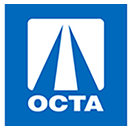OCTA is the first agency in the nation to reset a partially drawn TIFIA loan, taking advantage of low-interest rates to realize significant savings
 The Orange County Transportation Authority today reset the interest rate to 1.95 percent on its $629 million federal loan for the I-405 Improvement Project, a first-of-its-kind reset that will help save an additional $158 million over the life of the loan.
The Orange County Transportation Authority today reset the interest rate to 1.95 percent on its $629 million federal loan for the I-405 Improvement Project, a first-of-its-kind reset that will help save an additional $158 million over the life of the loan.OCTA finalized its initial loan in 2017 with a 2.91 percent interest rate through the Transportation Infrastructure Finance and Innovation Act, commonly called TIFIA.
Late last year, OCTA began working with the U.S. Department of Transportation’s Build America Bureau, the agency that runs the TIFIA program, to pay off its existing loan and execute a new one to take advantage of lower interest rates.
OCTA is the first agency to ever reset a partially drawn TIFIA loan, taking advantage of historically low interest rates to realize significant savings of $158 million on a new present value basis.
“I’m proud of OCTA for being proactive in taking advantage of low interest rates to help save millions of dollars for our taxpayers,” said OCTA Chairman Andrew Do, also the county’s First District Supervisor. “Thank you to our partners at the U.S. Department of Transportation for working with us to create a model on how to refinance a drawn TIFIA loan, setting an example for other transportation agencies throughout the country to save public funds that can be reinvested in our infrastructure.”
The TIFIA loan will be repaid solely using the revenue collected from drivers who choose to use the 405 Express Lanes being built as part of the I-405 Improvement Project.
Toll revenue collected beyond what it costs to repay the loan will fund transportation improvements for everyone who travels through the 405 corridor – whether or not they use the Express Lanes. The interest rate savings will allow more money to be available sooner to make those additional improvements along I-405.
“Innovative financing is critical to delivering major infrastructure projects and it’s great to see OCTA lead in this area to maximize available funding and continue making improvements for everyone who lives, works and drives near the 405 Freeway,” said Michael Hennessey, Chairman of OCTA’s Finance and Administration Committee. “This effort will help create greater revenue potential for future projects in the area.”
The original TIFIA loan for the I-405 Improvement Project was estimated to save about $300 million over the life of the loan compared to traditional bond financing, allowing the 405 Express Lanes to remain free to two-person carpools during non-peak hours when the express lanes open, a commitment made by OCTA.
To generate additional savings, OCTA is working on issuing Bond Anticipation Notes, a short-term financing tool used during the construction of projects, to allow OCTA to take advantage of lower short-term interest rates over the next three years instead of drawing on its TIFIA loan. The issuance of these notes is expected to save an additional $20 million.
“Every dollar we can save Orange County taxpayers in interest, is one more dollar we can invest in our infrastructure to enhance our transportation system,” said OCTA CEO Darrell E. Johnson. “I want to thank our federal partners and all those who played a role in helping to realize these tremendous savings.”
The $2.1 billion I-405 Improvement Project, now more than halfway complete, will add one regular lane in each direction of I-405 between Euclid Street and I-605, and a second lane in each direction in the center of the freeway from SR-73 to I-605 that will combine with the existing carpool lanes to form the 405 Express Lanes.
This 16-mile segment of I-405 is one of the most heavily traveled stretches of highway in the nation, and drivers routinely face severe congestion in both the regular lanes and carpool lanes. The project, anticipated to be completed in 2023, is critical to accommodate expected employment, population and housing growth throughout the region.
For more information about the I-405 Improvement Project, visit octa.net/405improvement.
About OCTA: The Orange County Transportation Authority is the county transportation planning commission, responsible for funding and implementing transit and capital projects for a balanced and sustainable transportation system that reflects the diverse travel needs of the county’s 34 cities and 3.2 million residents. With the mission of keeping Orange County moving, this includes freeways and express lanes, bus and rail transit, rideshare, commuter rail, environmental programs and active transportation.





